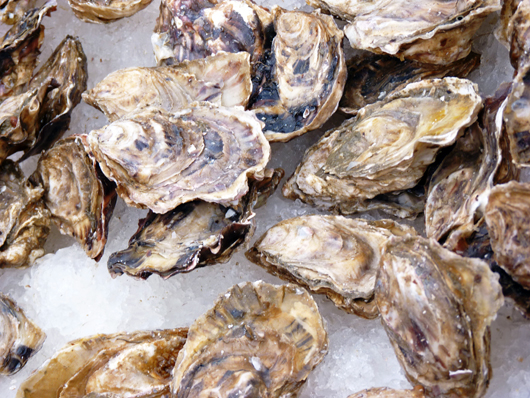(Click on “play” to see the OysterFest slideshow. Or click on a photo to see the next one.)
Robert Kinneen stands at a table, surrounded by shellfish and cooking gear.
“I’m going to be making oysters with a rhubarb shooter,” he tells a small crowd. “I’m going to start with a cup of water, then a third of a cup of brown sugar …”
Kinneen shared his recipes during OysterFest, held alongside the Southeast Native cultural event Celebration 2012. He holds a shucking knife in one hand and a microphone in the other, as he encourages his fellow Alaskans to try out – and experiment with – oysters.
“While they’re not indigenously found here, I think it’s a great opportunity to grow a beautiful-flavored specimen … (with) nice crisp clean subtle flavors,” he says. “They’re really, really tasty, and subtle on the brine. They’re just really amazing.”
Kinneen has been chef of the Seven Glaciers restaurant at the Alyeska Resort, Orso in downtown Anchorage, and other popular spots. He’s Tlingit, originally from Petersburg, with family ties to Sitka.
He works with the Alaska Seafood Marketing Institute, and is part of a regionwide effort to promote oysters from tribally-owned shellfish farms.
“The Alaska brand, the mystique behind the Alaska brand, always creates market opportunity for you,” says Russell Dick, president and CEO of Haa Aaní, LLC.
It’s the Sealaska Corporation subsidiary developing new Southeast businesses, including oyster farms.
“Everything we have in production today could get sold into the Alaska market easily. And as we look to expand, we certainly want to reach out into the other domestic markets and potentially internationally, if the logistics make sense and the economics make sense,” he says.
Sealaska doesn’t own oyster farms. But the Juneau-based regional Native corporation has formed partnerships with shareholders and tribal governments to set up three farms in Yakutat and one each in Kake and Angoon.
“Haa Aaní is planning on developing three more farms in Hoonah as well, with one five-acre parcel serving as an R&D mariculture site,” Dick says.
It’s not easy work.
“Sometimes it’s hard to get up and go out there because it’s blowing 40 or 50 knots and it’s snowing,” says Joy Klushkin, who left her job as business manager of Yakutat’s school district to become an oyster farmer. That was two years ago. “I’m still in shock when I come up to a table and I see they’re my oysters. I tell my husband, take a picture! I can’t believe it! Those are my oysters.”
Klushkin has about a half-million of the valuable shellfish growing in her farm. She just made her first delivery of around 25,000 to Haa Aaní’s OysterFest.
She and two other farms share an island about a five-minute skiff ride out of Yakutat’s boat harbor. There’s a lot of cooperation.
“We’ve actually learned a lot, and got a lot of information from others. It seems to be an industry that everybody is excited to promote,” says Cindy Bremner, president and CEO of Yak-tat Kwaan, the community’s village Native corporation.
It just harvested its first oysters, and hopes to produce as many as 3 million a year.
“So it’s not like they don’t want to share what they know with us because we’re going to have a better oyster. It’s an industry that seems to support each other, is what I’ve felt. And it makes it exciting,” she says.
The farms take young oysters – called spat – and grow them until they can be sold. That can take from two to three years, depending on a variety of factors.
Spat comes from nurseries, also called “Flupsys.” Kake has one. And Sealaska’s Haa Aaní subsidiary recently signed an agreement with the Hydaburg Cooperative Association and the Organized Village of Kasaan to develop, build and operate a larger nursery near Hydaburg.
Haa Aaní’s Russell Dick says marketing is also part of the job.
“As these continue to mature and grow out, and they produce there high-quality oysters, our role then becomes ensuring we can find the market outlet, and the best market outlet, that provides the highest margin for the farmers,” Dick says.
So far, they’ve been sold to restaurants and grocers in Southeast and Anchorage.
Back at OysterFest, chef Ron Kinneen is passing around a tray of half-shells with his rhubarb-ginger topping.
The taste is new to many, including farmers in attendance.
“I ate my first oyster just the other day. It was very, very good, but I had nothing to compare it against,” says Bremner, of Yak-tat Kwaan. “I decided I had better try one, since we’re in the oyster business. So I’m going to be excited to try them numerous different ways.”
These are not the only shellfish farms in Southeast. In addition to oysters, littleneck and geoduck clams have been grown and sold.
Note: The Alaska Seafood Marketing Institute provided some of the Oysterfest audio included in this report.
Links:
Alaska Shellfish Growers Association.


